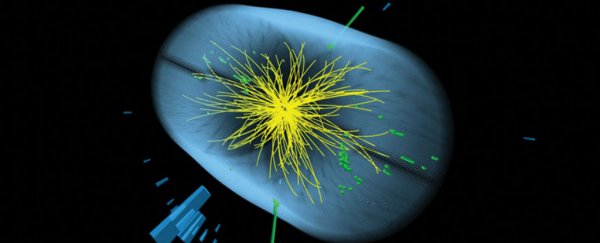Since the first hints of a new subatomic particle cropped up in results from the Large Hadron Collider (LHC) last December, physicists around the world have been scrambling to make sense of it.
We've now got literally hundreds of papers seeking to explain how this new particle could possibly exist within the context of our current understanding of the laws of physics - and if it can't, what that means for current understanding of physics.
Now four new papers have been published outlining the most likely explanations, and let's just say if any of these turn out to be right, particle physics as we know it will have to go through one of its most significant overhauls ever.
"If this thing is true, it's huge. It's very different than what the last 30 years of particle physics looked like," theoretical physicist David Kaplan from Johns Hopkins University told Emily Conover at Science News.
One thing to point out straight off the bat - we still don't actually know if this thing is real, or a statistical fluke, so there's a big, fat caveat floating over all this speculation until someone can prove that the telltale 'bump' in the data isn't a mistake.
But assuming it's not, here's what we know.
Last year, two experiments run at the LHC - called ATLAS and CMS - independently came up with a 'bump' in their data that didn't seem to make much sense, until the two teams compared them. These bumps were exactly the same across the two experiments, and pointed to a never-before-seen particle that, if real, would break the standard model of particle physics.
As we reported back in March, the two teams arrived at this data dump by smashing protons together inside the LHC, which ended up producing slightly more high-energy photons (light particles) than our best theories of physics can predict.
Specifically, both the CMS and ATLAS detectors recorded a spike in activity at a particular energy level, corresponding to around 750 giga electronvolts (GeV) - or roughly 750 billion electron volts.
What does that mean? The new particle appears to be decaying into two photons at the point of the collision - if it exists - and now physicists have to figure out how.
If you want to know exactly how physicists are processing all of this, there are now more than 300 papers sitting on the pre-press website, arXiv.org, just waiting for you to have a peruse, or you can even go straight to the raw data, if you're really keen.
But if that sounds like something you'll get around to doing… never, don't worry - the journal Physical Review Letters has just published four new papers that summarised the best and most likely hypotheses for what this new particle could be.
One of most likely explanations for the strange data bump is that the new particle is a conglomerate of smaller bits - much like the protons and neutrons that make up atoms are made of smaller quarks, says Conover at Science News.
Some kind of 'quark-like' particles could be held together by an unknown force, and that could be the basis of the new particle, physicists have suggested. "I think that that's the model that works the best with the data," theoretical physicist Kathryn Zurek of Lawrence Berkeley National Laboratory in California told Conover.
Another explanation, which you've probably heard about over the past few months, is that the new particle might be very similar to the Higgs boson, only it'd be around 12 times heavier.
Or perhaps the new particle is a combination of these two explanations - maybe the Higgs boson itself is made up of a bunch of smaller particles.
The fourth explanation put forward by physicists for this new particle is that it's a graviton - an hypothesised particle that carries the force of gravity.
"That would be truly remarkable," Ian Sample wrote for The Guardian back in March. "So far, gravity has proved impossible to reconcile with theories of other particles and forces."
As Science News explains, the biggest challenge physicists are facing right now in explaining the mysterious blip in the data is that it's so far only revealed itself in one type of decay, where it produces two photons.
If it decays to two photons "you might expect that it also goes to other things, and the fact that we don't see that makes it difficult for many models to be right", says theoretical physicist Matthew Buckley of Rutgers University.
What also doesn't seem to make much sense is that fact that every explanation physicists have come up with so far doesn't really solve any of the existing 'holes' in our understanding of particle physics - such as what the eff dark matter is, and how the Higgs boson can have a much lower mass than expected.
While many physicists are trying to explain the existence of a new particle, others have been telling us for months not to hold our breath.
"I would love for it to persist, but I've seen so many effects come and go that I have to say in my heart of hearts I'm not very optimistic," physicist John Ellis from King's College London, and the former head of theory at CERN, told The Guardian. "It would be such a fantastic discovery if it were true, precisely because it's unexpected, and because it would be the tip of an iceberg of new forms of matter."
We'll just have to wait and see, but we're definitely narrowing in on this thing… if it's real.
You can access the four papers in Physical Review Letters here.
